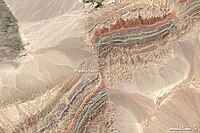
Photo from wikipedia
Abstract In this study, we quantify the mechanisms that govern two related observations with regard to deep (15–50 km) subduction-zone aseismic slow-slip events (SSEs): (i) the linear scaling relationship between seismic… Click to show full abstract
Abstract In this study, we quantify the mechanisms that govern two related observations with regard to deep (15–50 km) subduction-zone aseismic slow-slip events (SSEs): (i) the linear scaling relationship between seismic moments (M0) and event durations (T), and (ii) the direction-dependent slow-slip rupture speeds. Geological observations suggest that deep-subduction slow-slip shear zones are anisotropic and viscoplastic; the anisotropy is due to the presence of dip-parallel mafic lineaments created by seamount subduction, whereas the viscoplasticity is due to deformation of mixed brittle mafic and ductile felsic materials. We postulate that a dip-parallel (=slip direction) mafic lineament in an overall felsic slow-slip shear zone acts as a stress guide, which localizes initial slow-slip rupture in the dip direction. Subsequent stress concentration along the dip-parallel edges of the early ruptured lineament leads to along-strike rupture, with the rupture front propagating through the felsic shear zone. The second-phase slip-area expansion maintains a constant dip-parallel rupture-zone length, inherited from the length of the early ruptured mafic lineament. By combining an energy balance equation with a two-phase rupture model outlined above, we obtain the first analytical expression of the observed linear scaling law in the form of M0 = c0T, where c 0 = 4 γ 1 Δ z G 2 L 2 μ ¯ s − μ ¯ d ρgH Δ z η e cos δ + V FW 2 L Δ z μ ¯ s 2 − μ ¯ d 2 ρgH 2 − 4 γ 1 G L + Δ z − ρ Δ zLG V FW + v a 2 ; the observed value of this empirical constant is between 1011.5 and 1013.5 J/s. In the above expression, L, H, Δz, δ, G, ηe, μ ¯ s , and μ ¯ d are length, depth, thickness, dip angle, shear rigidity, effective viscosity, and effective coefficients of static and dynamic friction of the slow-slip shear zone, γ1 is surface-energy density of the initially ruptured mafic lineament, ρ is overriding-plate density, VFW and va are subducting-plate and slow-slip velocities, and g is surface gravity. Our model, based on the assumed shear-zone anisotropy, successfully predicts fast (~100 km/h) dip-parallel rupture along high-viscosity (~1020 Pa s) mafic lineaments and slow (2–10 km/day) strike-parallel rupture through low-viscosity (~1017 Pa s) felsic materials during a deep-subduction slow-slip event.
Journal Title: Tectonophysics
Year Published: 2019
Link to full text (if available)
Share on Social Media: Sign Up to like & get
recommendations!